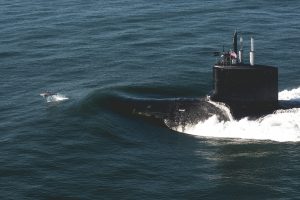The U.S. Navy commissioned the 7,800-ton Virginia-class nuclear-powered attack submarine (SSN), USS Delaware (SSN-791), on April 4, the service announced earlier this month. The submarine was scheduled to be commissioned last Saturday at the Port of Wilmington. Restrictions on public gatherings due to the coronavirus pandemic saw the USS Delaware administratively commissioned and transitioned into normal duties, according to the U.S. Navy.
“Although the traditional public commissioning ceremony was canceled for public health safety and due to restrictions on large public gatherings, the Navy commissioned USS Delaware administratively and transitioned the ship to normal operations,” the Navy said in a statement. “Meanwhile, the Navy is looking at a future opportunity to commemorate the special event with the ship’s sponsor, crew and commissioning committee.”
The USS Delaware is the Navy’s 18th Virginia-class SSN and the ninth boat built by U.S. ship maker Huntington Ingalls Industries’ (HII) Newport News Shipbuilding division as part of a teaming agreement with General Dynamics Electric Boat.
The boat was delivered to the Navy in October 2019. The Delaware was christened by Jill Biden, the former Second Lady of the United States and the ship’s sponsor, at HII’s Newport News shipyard in October 2019. The submarine was launched in December 2018.
“I know this submarine and her crew of courageous sailors will carry the steadfast strength of my home state wherever they go,” Biden was quoted as saying by the Navy. “The sailors who fill this ship are the very best of the Navy, and as you embark on your many journeys, please know that you and those whom you love are in my thoughts.”
Construction of the submarine began in September 2013. The Delaware is the eight and final Virginia-class Block III SSN to be commissioned into service.
Virginia-class attack Block III SSNs are equipped with so-called Virginia Payload Module (VPM) – two large-diameter tubes that replace 12 individual vertical launch tubes and increase the submarine’s missile payload at a lower cost. As I explained previously:
While the first 10 Block I and Block II Virginia-class submarines feature 12 individual 21-inch diameter vertical launch tubes able to fire Tomahawk Land Attack Missiles (TLAMS), the Block III boats are built with two-larger 87-inch diameter tubes able to house six TLAMS each (…) The new 87-inch tubes have been designed to accommodate future missile systems in addition to the Tomahawk.
The submarines can carry up to 24 torpedoes and TLAMS. Furthermore, I noted:
In addition, Virginia-class Block III boats are equipped with four torpedo tubes for MK48 torpedoes. Furthermore, next to a redesigned bow, Block III Virginia-class boats also contain a water-backed Large Aperture Bow [LAB] (…) sonar array that replaces the air-backed sonar sphere found in the first 10 [Virginia-class subs.] This, in combination with the its so-called fly-by-wire capability, enables the boat to perform important intelligence and surveillance missions.
The new LAB sonar array reportedly requires fewer parts and less maintenance than previous Virginia-class sonars.
Notably, the U.S. Navy also intends to deploy its conventional prompt strike (CPS) hypersonic weapon on Virginia-class SSNs in the future. “The Navy’s CPS program will design a missile comprised of a Common Hypersonic Glide Body (C-HGB) and a 34.5 inch two-stage booster,” the Navy’s Fiscal Year 2021 budget overview reads. “The program is pursuing an [initial operational capability] of FY 2028 in which the missile will be fielded on a Virginia class submarine with Virginia Payload Module [VPM].”
































